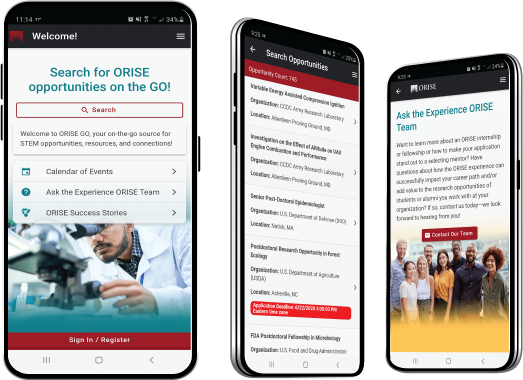USFS Fellowship in Mapping Satellite Data and Network Design Optimization
Connect with ORISE...on the GO! Download the new ORISE GO mobile app in the Apple App Store or Google Play Store to help you stay engaged, connected, and informed during your ORISE experience and beyond!
A complete application package consists of:
- An application
- Transcript(s) – For this opportunity, an unofficial transcript or copy of the student academic records printed by the applicant or by academic advisors from internal institution systems may be submitted. Selected candidate must provide proof of completion of the degree before the appointment can start. All transcripts must be in English or include an official English translation. Click Here for detailed information about acceptable transcripts.
- A current resume/CV
- Two educational or professional recommendations. Applications need at least one recommendation submitted in order to be viewed by the mentor.
All documents must be in English or include an official English translation.
*Applications will be reviewed on a rolling-basis.
USFS Office/Lab and Location: A fellowship is available with the US Department of Agriculture (USDA) Forest Service within the Eastern Forest Environmental Threat Assessment Center (EFETAC), located in Asheville, North Carolina. Teleworking may be possible.
Research Project: This is a combined project, comprising effort toward two different research programs outlined below. The participant’s effort will be split two thirds on ForWarn Sentinel 3 and one third on the Experimental Forest and Rangeland Network (EFRN).
ForWarn II (https://forwarn.forestthreats.org) has produced over a dozen map products showing forest disturbances across North America every 8 days for the last 10 years, but the two MODIS satellites on which it depends will be moved to lower orbits in 2022, and destroyed one year later. Two newer Sentinel 3 satellites now provide an alternative data stream to continue ForWarn. Sentinel-3’s S3A and S3B satellites have a revisit time of less than 2 days, with a resolution of around 300m.
ForWarn produces “departure” maps that show deviations, both negative and positive, from “normal” forest conditions. ForWarn produces a suite of disturbance map products every 8 days which differ primarily in the historical depth that is used for this departure comparison. Forest managers gain important disturbance insights by looking across ForWarn products using this changing historical perspective.
Interpretation of forest disturbances and their impact requires comparison with a lengthy historical archive going back 10 years or more, but Sentinel 3 satellites were only launched about three years ago. This need for historical perspective to detect and interpret disturbances also necessitated developing a backwards-compatibility with our existing library of stored MODIS NDVI maps that will allow their continued use as “normal” baselines to produce a full multi-year historical suite of new ForWarn departure products into the future.
The performance of any network of experimental sites depends on how well the experimental conditions at those sites reflect or represent the conditions occurring throughout the greater area that the network is supposed to represent. Many experimental networks, including the Experimental Forest and Rangeland Network (EFRN), have added sites in an undirected, ad hoc way, through a process of simple organic growth. But a new, quantitative ability to statistically analyze and map network representativeness and constituency shows locations whose conditions are well-represented by existing EFs, as well as poorly represented locations where additional, new EFs need to be added into the EFRN.
Such quantitative network analysis provides the ability of network analysis to actively guide the addition of new EFs into the network, in order to achieve the greatest increases in EFR network representativeness. Existing State and National Forests are the most likely candidates for additions to the EFRN. Statistical network analysis can direct the recruiting and addition of only the best new Forests: the ones which will provide the greatest new increment of added network representativeness to the EFRN. Instead of blind growth, an ordered list of the most-preferred Forests to be added will result in planned growth of the EFRN, and the maximized network representativeness that results will provide the greatest advantage per Forest that is added to the network.
Learning Objectives: The participant will help to develop and evaluate new Sentinel 3-based ForWarn disturbance maps, in comparison to their MODIS-based counterparts, as well as developing and testing entirely new ForWarn products. The participant will interact in a team environment with research collaborators and with forest management professionals to design, construct, execute and communicate complex programming tools and applications that are likely to include quantitative analysis (e.g., satellite data and/or maps of environmental characteristics) and to produce landscape maps of ecological results. Research may include downloading and integrating spatial datasets, such as remotely sensed data and environmental data, as well as integrating data-driven and expert-driven information.
The participant will help to provide an optimized design guide for the EFR network, at two scales: SRS southeastern subset, and national. This guide will be a sorted list, in preference order, of all existing state and national forest candidate sites that might represent the most likely candidates for adding to the existing EFRN. Calculated quantitatively against the existing, current constellation of EFRN sites, the list will allow guided rather than blind growth, and will maximize the representativeness and experimental utility of the EFRN as it grows in the future.
Mentor: The mentor for this opportunity is William Hargrove (william.w.hargrove@usda.gov). If you have questions about the nature of the research please contact the mentor.
Anticipated Appointment Start Date: May 2022 or as soon as a qualified candidate is identified. Start date is flexible and negotiable, and will depend on a variety of factors.
Appointment Length: The appointment will initially be for eighteen months, but may be extended upon recommendation of USFS and is contingent on the availability of funds.
Level of Participation: The appointment is full-time.
Participant Stipend: The participant will receive a monthly stipend commensurate with educational level and experience. A stipend of $7,075 per month will be provided. Health insurance will be provided along with a travel/training allowance.
Citizenship Requirements: This opportunity is available to U.S. citizens and Lawful Permanent Residents (LPR) only.
ORISE Information: This program, administered by ORAU through its contract with the U.S. Department of Energy (DOE) to manage the Oak Ridge Institute for Science and Education (ORISE), was established through an interagency agreement between DOE and USFS. Participants do not become employees of USDA, USFS, DOE or the program administrator, and there are no employment-related benefits. Proof of health insurance is required for participation in this program. Health insurance can be obtained through ORISE.
Questions: Please visit our Program Website. After reading, if you have additional questions about the application process please email USForestService@orise.orau.gov and include the reference code for this opportunity.
The qualified candidate should have received a master's degree in one of the relevant fields.
Experience and ability with linux, shell script programming, and GIS is preferred.

 ORISE GO
ORISE GO

The ORISE GO mobile app helps you stay engaged, connected and informed during your ORISE experience – from application, to offer, through your appointment and even as an ORISE alum!





